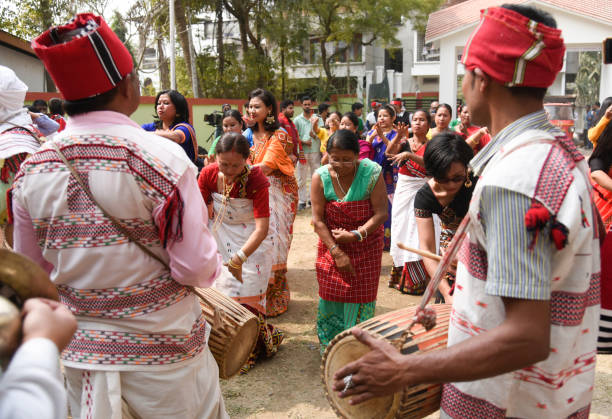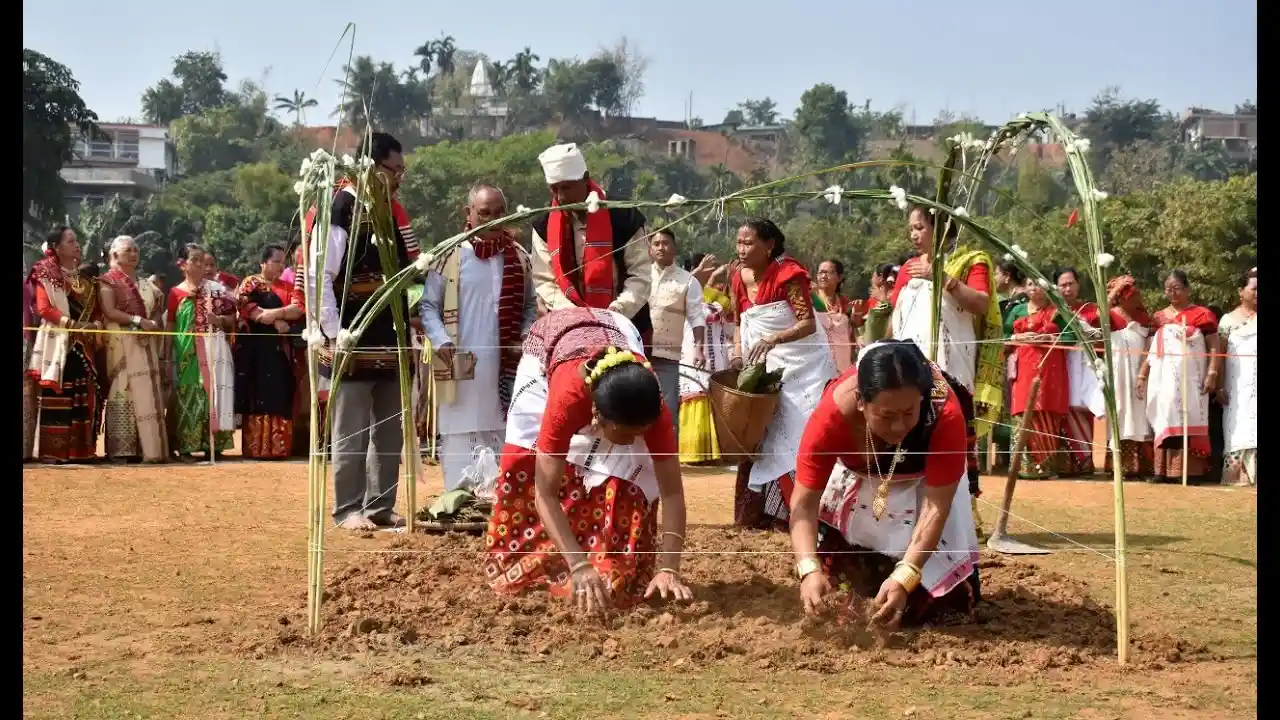Ali Aye Ligang is the main festival of the ethnic Mishing community, the second-largest tribe in Assam, India. This traditional festival is celebrated on the first Wednesday of the Phagun month, which falls in mid-February, marking the beginning of agricultural activities. The name “Ali Aye Ligang” carries deep significance: “Ali” means seeds, “Aye” refers to fruits, and “Ligang” means sowing. Historically, the Mishing people were agriculturists who relied on roots and fruits as staple foods. With the influence of Aryan culture, rice cultivation gradually became a part of their agricultural practices.
The festival symbolizes the start of sowing “Ahu” paddy, an essential crop, and is celebrated with rituals, dances, prayers, and feasting. Traditionally, the date of Ali Aye Ligang varied by locality, but in 1956, the Mishing community’s main socio-cultural organization, “Mising Nane Kebang,” decided to standardize the celebration on the first Wednesday of Phagun, considered an auspicious day known as Lakshmi Day.
On this day, the head of each family marks the beginning of the sowing season by performing a ceremonial act in the field. They carry seeds, traditional items like Yokpa, Apong, Purang, and others, in a VGVN (a cone-shaped bamboo structure). The ritual involves cleaning a small patch of land, decorating it with sacred items, and sowing seeds while chanting prayers to their forefathers—Sedi Melo, Karsing-Kartag, Do:Nyi-Po:Lo to bless the crops with abundance. The ceremony signifies a promise to share the harvest with both benefactors and those in need. Following the rituals, the women prepare Apong (rice beer) and Purang (a traditional dish), essential components of the festival.
Historical Context and Significance
- Origins:
- Ancient Roots: Ali Aye Ligang traces its origins to a time when the Mishing people were primarily agrarian. They lived in close harmony with nature, cultivating roots, fruits, and other crops in the hills of Assam.
- Sacred Connection: The festival emerged as a celebration of their deep connection to the land, emphasizing the importance of sowing seeds and nurturing the soil.
- Changing Traditions:
- Aryan Influence: As external influences, including Aryan culture, seeped into their lives, the Mishing people adapted their practices.
- Shift to Rice Cultivation: Rice cultivation gradually replaced other crops. However, the essence of their agrarian heritage remained intact.
- Symbolism: Ali Aye Ligang became a symbol of resilience, continuity, and reverence for the earth.
In summary, Ali Aye Ligang bridges ancient traditions with evolving cultural dynamics, embodying the Mishing people’s enduring bond with the land and their agricultural legacy.
The Date and Rituals
- Date:
- Celebration Day: Ali Aye Ligang is observed on the first Wednesday of the Phagun month, which typically falls in mid-February.
- Lakshmi Day: Within the Mishing community, this day holds special significance and is often referred to as “Lakshmi Day.” It symbolizes prosperity, abundance, and blessings for the upcoming agricultural season.
- Sowing Seeds Ritual:
- Preparation: On Ali Aye Ligang, the head of each family visits their fields. They choose a small patch of land in the eastern part of the field.
- Cleanliness: The headman meticulously cleans the chosen area, removing any debris or weeds.
- Decorations: The field is adorned with traditional offerings called “PEERO” and symbols known as “SI-PAG ONNO.”
- Sowing Seeds: Holding a handful of seeds, the headman sows them into the prepared soil. As they plant, they chant the names of their forefathers, invoking their blessings.
- Promise: The family makes a solemn promise to share the harvest with both benefactors and beggars, emphasizing community welfare and gratitude.
In summary, Ali Aye Ligang is not only about sowing seeds but also about nurturing traditions, connecting with ancestors, and fostering a sense of unity within the Mishing society.
Dance, Music, and Community Bonding

- Traditional Dances: “Gumrag Soman”
- Vibrant Celebration: Ali Aye Ligang bursts forth with energy as the Mishing community gathers to dance. The “Gumrag Soman” dance takes center stage.
- Unity and Fertility: In this rhythmic dance, participants celebrate unity, fertility, and the promise of a fruitful harvest. Their synchronized movements echo the pulse of the earth.
- Colorful Attire: Dancers wear traditional Mishing attire, adorned with vibrant colors and intricate patterns. The beat of drums and bamboo flutes sets the tempo.
- Feasting and Togetherness:
- Sumptuous Feast: After the rituals, families and neighbors come together for a grand feast. The air is filled with the aroma of traditional Mishing delicacies.
- Shared Tables: People sit side by side, sharing stories, laughter, and blessings. The feast symbolizes abundance and community spirit.
- Culinary Delights: Expect dishes like “Apong” (rice beer), “Poro Aapong” (sticky rice cakes), “Purang Apin” (a type of bread), and various fish and meat preparations.
Unity and Modernization
- Unity:
- Education and Exposure: As Mishing society embraced education and interacted with modern civilization, a sense of unity emerged. Education bridged gaps and fostered understanding among community members.
- Collective Decision: In 1956, the Mishing people made a unanimous decision to celebrate Ali Aye Ligang. This collective choice transcended local variations and reinforced their shared identity.
- Cultural Pride:
- Generational Connection: Ali Aye Ligang serves as a cultural anchor, connecting generations. It reminds them of their roots, heritage, and the importance of preserving their unique customs.
- Identity Preservation: Amid modern influences, the festival has become a powerful symbol of cultural pride. It reaffirms their distinctiveness and strengthens their bond as a community.
Conclusion
Ali Aye Ligang is more than just a festival for the Mishing community; it is a celebration that encapsulates their deep-rooted connection to agriculture, nature, and cultural heritage. This festival marks the beginning of the sowing season and symbolizes prosperity, unity, and gratitude towards the earth and ancestors. Over time, Ali Aye Ligang has evolved from a localized celebration to a unified cultural event, reinforcing community bonds and preserving traditional practices in a rapidly changing world. The rituals, dances, and feasts associated with the festival not only reflect the Mishing people’s agrarian lifestyle but also serve as a means to transmit their rich cultural legacy to future generations. In essence, Ali Aye Ligang stands as a testament to the Mishing tribe’s enduring respect for nature, communal harmony, and cultural pride.
FAQ’s
Q. What is Ali Aye Ligang?
A: Ali Aye Ligang is a traditional festival celebrated by the Mishing community of Assam, India. It marks the beginning of the sowing season for crops, particularly “Ahu” paddy, and is a time of rituals, dances, and feasts.
Q. When is Ali Aye Ligang celebrated?
A: The festival is celebrated on the first Wednesday of the Phagun month, which typically falls in mid-February. This date was standardized in 1956 by the Mishing community’s socio-cultural organization, “Mising Nane Kebang.”
Q. What activities are common during Ali Aye Ligang?
A: Apart from rituals and feasts, the festival is known for traditional dances like the “Gumrag Soman” and singing of folk songs that reflect the Mishing way of life and their connection to the land.




